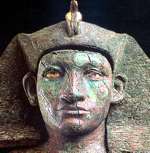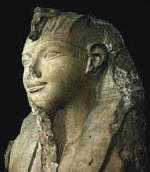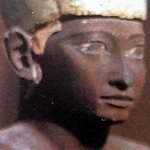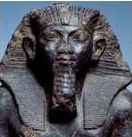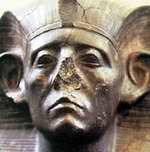| 12th Dynasty (213) 1991-1778BC | |
| A great dynasty, the power of which was comparable with that of the Old Kingdom. The building works all over Egypt have practical aspects, causing immense industrial development. The kings introduce co-regency to facilitate a succession to the throne as a permanent element of rule. After all they were brilliant administrators, builders and warriors. Many important pieces of literature have been written at that times: Precepts of Amenemhet, Tail of Sinuhe, Story of the Shipwrecked Sailor, Story of the Oasis inhabitant, Loyalistic Precepts showing relationship between loyality to the king and private happiness, The Dramatic Papyrus, Semna Dispatches – records of a crew of fortresses at Nubian boundary, Eloquent Peasant, and many more. Base of this collection are 23 papyri found by Quibell in 1896 at Ramesseum. | |
|
Amenenhet |
|
|
His
origin is unknown, maybe vizier of Mentuhotep IV, an according to
one of hypotheses might have been also coregent of the latter (a pot
of Lisht presents names of the two rulers). He enhanced power of
nomarchs, reformed administrative system of the Land. Originating
from Thebes, he founded a capital at Itj-tawy (Lisht). One of his
numerous wives was queen Nefru-Tatenen, mother of Senweseret
I, another wife was called Didit. Numerous traces of building
activities – Kantir, Bubastis, Heliopolis, Memphis, Wadi Natrun,
Abydos, Dendera, Koptos, Tod, Thebes and more. In 29 year of his
reign he organized campaign to Nubia, he warred also against Asiatic
Bedouins. 11 years before his death (1971 BC) he associated his
eldest son with him as coregent. He was murdered in a court coup at
a time Senweseret
was away. However this hypothesis is not fully proved. Burial place
- pyramid complex at Lisht, near the residence at Itj-tawy. Apart
from the ruler’s pyramid, the complex included tombs of queen and
princesses and mastabas of court nobles. The side of king’s pyramid
was 55m long and its slope was 54o.
Amenemhet I took the throne after Mentuhotep IV -- in fact, he may have been a co-regent for a while with the old king. Either that, or he usurped the throne from the regining king (but remember that this kind of theory is hardly supported by contemporary sources). Even if it was a usurpation, it was apparently a peaceful coup. He was the son of a priest named Senusret and a woman called Nefret. He had no real relationship to the royal line except as vizier and general for the previous pharaoh, Mentuhotep IV. It is assumed that these two are the same man -- vizier and pharaoh -- and might explain how a non-royal man was able to gain the throne of Egypt. The obvious break with the royal family of the Theban kings in the 11th Dynasty explains why Amenemhet is considered the first king of the new dynasty. His name alludes to a a previously unknown god, Amun, who was established in Thebes during the 11th Dynasty. Even though Egypt was prosperous and united under the previous dynasty, Amenemhet I reorganized the country administration. In some cases he divided the nomes into different townships and reallocated power to those to those nomarchs (governors) who supported him. During most of the First Intermediate Period, the local rulers of the nomes had risen to almost absolute power, with little respect (or even attention) to the central government in Thebes. It was for this reason that he founded a new administrative center on the border of Upper and Lower Egypt. He named this new capital Itjtawyamenemhet ("Amenemhet is seizer of the two lands"), probably located near Lisht, where he built his pyramid. It is interesting to note that he didn't move back to Memphis, the home of previous dynasties, is interpreted as a shrewd political move to distance himself from the previous government and force the nobles to abandon their own territories to retain power. Like nearly every pharaoh before him, Amenemhet continued to war against the Libyans and Asiatics. In the Sinai, he erected the "Wall of the Prince" to guard the eastern borders of Egypt. Other than that, though, his military exploits were fairly uneventful. Politically, he re-established diplomatic contacts with Byblos in Lebanon, and returned conscription to the armed forces. In addition, he re-established control over Nubia late in his reign, despite strongly controlling Elephantine. While his military exploits followed the same pattern as the pharaohs of the 11th dynasty, the rule of Amenemhet I opened a golden age for Egypt. One of the legacies he left to Egypt was the Testament of Amenemhet (which is included in a number of papyri) which defined the royal obligations of the pharaoh and the needs of the people. Outlining the perils of being pharaoh, it describes the kind of man a pharaoh should be and the kind of life he should lead-- that loneliness and personal sacrifice are the hallmarks of a good king. Near the end of his reign, Amenemhet I made his son, Senusret I, co-regent (in about 1971 BCE). A military campaign against the Libyans was led by Senusret. While he was away, Amenemhet was assassinated in a plot that originated in his harem of wives and consorts. He was attacked while sleeping and while later stories tell how he bravely defended himself, he was eventually slain by his own bodyguards. It is quite possible that the assassination of Amenemhet I while his co-ruler and son was away may have been an attempt to disrupt the power of the 12th Dynasty and regain the throne by the remnants of the nobility and regional kings. Amenemhet left remarkably few monuments, building only a pyramid complex at Lisht that includes five mastabas for his family and retainers, 22 burial shafts and his own burial chamber. A partially complete tomb in Thebes was abandoned for this new location, again probably a political move. The pyramid, named "Amenemhet is high and pleasant", is meant to recall the glory of the fourth dynasty pyramid builders and the Pyramid age of the Old Kingdom. However, Egypt was not as prosperous and powerful during Amenemhet's rule as his predecessor and his pyramid is less imposing. The core of the pyramid is rough-cut stone and mud brick, and the casing of smooth limestone is mostly gone, only a pile of rubble remains today. It is located between Saqqara and Maidum, and can be seen from the main road to Cairo. Initially excavated by Maspero in 1882, it was initially noted that the blocks used in the pyramid were salvaged (or stolen) from other monuments. Stones with the names of Khufu, Khafre, Unas, and Pepi have been found on the site! It is common enough to reuse stone -- the old monuments were an easy source of already-smoothed stone -- and most of the ancient monuments have been used as convenient quarries. He did add on or built a number o temples in remote areas, including monuments in Bubastix,, Tanis, Karnak, Coptos, Abydos, Dendara and, finally, in Memphis where he built a temple to Ptah. His origin is unknown, maybe vizier of Mentuhotep IV, an according to one of hypotheses might have been also coregent of the latter (a pot of Lisht presents names of the two rulers). He enhanced power of nomarchs, reformed administrative system of the Land. Originating from Thebes, he founded a capital at Itj-tawy (Lisht). One of his numerous wives was queen Nefru-Tatenen, mother of Senweseret I, another wife was called Didit. Numerous traces of building activities - Kantir, Bubastis, Heliopolis, Memphis, Wadi Natrun, Abydos, Dendera, Koptos, Tod, Thebes and more. In 29 year of his reign he organized campaign to Nubia, he warred also against Asiatic Bedouins. 11 years before his death (1971 BC) he associated his eldest son with him as coregent. He was murdered in a court coup at a time Senweseret was away. However this hypothesis is not fully proved. Burial place - pyramid complex at Lisht, near the residence at Itj-tawy. Apart from the ruler’s pyramid, the complex included tombs of queen and princesses and mastabas of court nobles. The side of king’s pyramid was 55m long and its slope was 54o. Alternative dates
1994-1964 (Dodson) |
|
|
Senusert I |
|
|
Son
of Amenemhat I by queen Nehru-Tathenen. Having adjusted internal
affairs related to the murder of his father he started conquest of
Nubia. His army reaches to the III Cataract. In year 24 of his
reign Egyptian army commanded by Nesmonth campaigned against
Bedouins. Three years before his death he admitted to co-regency his
son Amenemhat III. Building activities of this ruler are known as:
Satis chapel at Elephantine, Edfu, Hierakonpolis, El-Kab, Temple of
Montu at Tod, numerous structures at Karnak, dendera, Abydos and
many other places all over the Land. Burial place – pyramid complex
at Lisht, 2 km south to the Amenemhat I pyramid. 9 minor pyramids of
queens and princesses are surrounding the king’s one. In the New
Kingdom period Sesostris was deified and worshipped as a god
protecting Theban necropolis. Alternative dates 1974-1929
(Dodson)
|
|
|
Amenemhet II |
|
|
Son
of Senweseret
I. During his
reign
he developed trade with neighboring countries, organized expeditions
to Nubia and Punt. He also encouraged partnership with Asiatic
countries. Some punitive expeditions were also recorded at that
time, expedition to Syria resulted in occupation of two fortified
cities and more than 1500 captives were sent to Egypt. They were
next employed by building works at royal necropolis. To great extent
the king reinforced independence of nomarchs, who were allowed to
keep army of their own. Burial place - white pyramid at Dahshur
built of white limestone from Tura is now greatly damaged and poorly
explored. There is a limestone sarcophagus in funerary chamber Alternative dates 1932-1896 (Dodson) 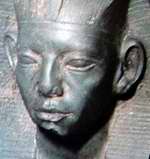
|
|
|
Senusert II |
|
|
Turin
Canon assigns 19 years of rule, although the lack of relics dated to
the times before year 9 year of his rule lets us to verify this
opinion. To great degree he enforced the economy mainly thanks to
the land drainage near Fayum. It is known that he lead some military
operations at Nubia where he started to build a stronghold at
Mirgissa. Similarly to predecessors, his funerary complex was
located near el-Lahun, Base of the pyramid is 107 m long, height -
48m, entrance hidden in the southern wall. Funerary chamber were
found: red granite sarcophagus, sacrificial table and gold uraeus
from the king’s circlet. Senweseret
II was the father of Senweseret
III and Senweseret-Seneb
and princesses: Sathathor-Junat, Hatshepsut, Nofret, Itakait. Alternative dates 1900-1880 (Dodson)
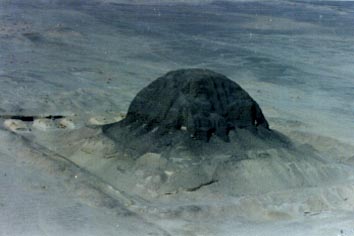 Ruin of
pyramid at
el-Lahun
Ruin of
pyramid at
el-Lahun
|
|
|
Senusert III |
|
|
Son
of Senweseret II. Very energetic and warlike
ruler. He warred in Nubia and Asia, also in Libya. He moved southern
boundaries of Egypt as far as beyond the Second Cataract. Turin
Canon gives 30 years of rule while most historians (Schneider,
Lerhnar, Bietak, Franke) assume 19 years.
Another group of scholars (Helck, Beckerath) believe that Sesostris
III ruled much longer. Their hypothesis is based upon newly
discovered (in 1994) at Abydos inscription from Senuseret’s
cenotaph, which records events from 39 year of his rule. A few
campaigns in Nubia and at least one in Asia Minor prove his
incredible military dispositions. Making a canal by the Third
Cataract facilitated the Egyptian fleet access to Semna at the
Second Cataract, where numerous fortresses were built.
Senuseret left after him many temples at Armant, Medamud, Abydos,
Faiyum, Bubastis. His burial place including also his royal wife
Sebekshedti-Neferu and children - pyramid complex at Dahshur
patterned on Djoser’s complex. No stone at the core (mudbrick
covered with limestone from Tura) resulted in vast damage of the
edifice. Since New Kingdom Senweseret was
worshipped, especially at Nubia. He was the hero of ancient story, a
king-warrior and predecessor of the greatest conquerors - Tuthmosis
III, Ramesses II and Alexander the Great. Alternative dates 1881-1840 (Dodson)
|
|
|
Amenemhet III |
|
|
Son
of Senweseret
III and queen Sebekshedti-Neferu. Great builder and organizer. He
farmed the Faiyum Oasis and Lake of Moeris erecting at el-Lahun a
dam.
Near
Dahshur he erected his
first pyramid,
with burial places of royal wives and daughters
around it.
At city of
Hawara he ordered to build second pyramid and gorgeous mortuary
temple, called later by Greeks the Labyrinth. At the Hawara
pyramid, a putative burial place of Amenemhat , burial chamber was
hollowed out in huge quartzite block, weighing 110 tons. This
magnificent funerary complex is sometimes recognized as a legendary
Labyrinth, has been partly damaged yet during the dynasty XIII
and since then has been undergoing successive erosion. Amenemhat
exploited turquoise mines in Sinai and quarries at wadi Hammamat,
Tura, Toshka, Wadi el-Hudi. He sent war campaigns to Nubia and
erected fortresses. Apart from funerary complexes at Dahshur and
Hawara he built at Biahmu (colossal statues), Medinet Maadi (Temple
of Renenutet and Sobek) , temple of Sobek at Crocodilopolis, temple
of Harsafes at Ehnasija el-Medina and at Bubastis, Memphis, Abydos,
Kuban. The king was still worshipped as Lameres in Roman period.
Turin Canon gives 40 years of rule. Alternative dates 1842-1794 (Dodson)
|
|
|
Amenemhet IV |
|
|
Supposedly
son of Amenemhat III (or his grand-son), succeeded the throne
after long lasting reign of his father, being himself at that time
rather aged. From his reign the Egyptian empire slowly comes into
disorder. Four expeditions to Sinai for building purposes are
recorded. Traces of building activities of Amenemhat IV are found
also at Crocodilopolis, Heliopolis, Medinet Maadi, Semna in Nubia.
Having no male successor he left the throne to his sister – wife,
Sobekneferure.
Presumably pyramid at Mazguna (between Memphis and Fayum) was his
burial place.
Turin
Canon gives 9 years, 3 months and 27 days of rule. Alternative dates 1814-1805
(Malek) |
|
|
Queen Sabek-neferu-re |
|
|
Turin
Canon assigns 3 years, 10 months and 24 days of rule, while Manetho
- 4 years. She was younger sister (and wife) of Amenemhat IV,
presumably daughter of Amenemhat III. Statues of Tell ed-Daba and
architrave of Herakleopolis are preserved. Inscription on the
nilometer at Nubian Semna records 3 years of her rule. Building of
pyramid at Mazghuna has not been completed, and probably never used,
only its underground part was finished. Alternative dates 1805-1801
(Malek) |
|
